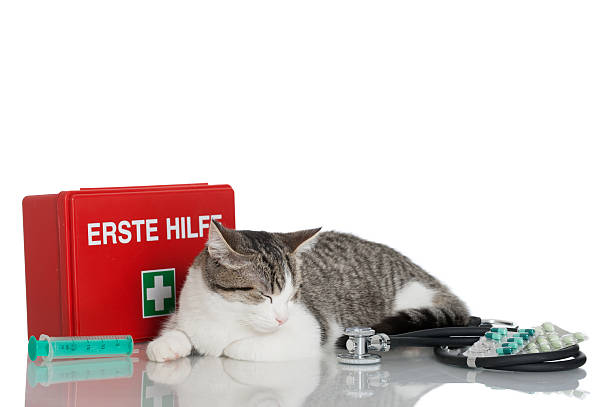Cats are inquisitive and naughty animals. They must squeeze themselves into the smallest area, climb the highest shelf, eat items that shouldn't be consumed, and play with non-toy stuff. Knowing the basics of cat first aid is crucial if you live with a feline. But never forget to give your veterinarian a call in the event of any injuries or issues.
Avoidance
Because prevention is vital, keep your cat indoors unless under supervision. Make use of pet-friendly items that won't burn your skin when applied to the skin and are safe to consume. Learn which foods, plants, and even essential oils might cause poisoning in cats. Breakable objects shouldn't be left in places where your cat can get to them. Before using your washer and dryer, give them a check. Maintain a close eye on your cat to see any symptoms of illness or injury, and set up a First Aid Kit for your furry friend so you'll be ready for anything.
What a Feline First Aid Kit Contains
You'll be better equipped to handle the most frequent injuries if you have the following supplies on hand:
Important Items for a Cat First Aid Kit:
• Cotton wool, swabs, and absorbent gauze; • Elizabethan collar
Sterilised saline solution; bandages; surgical tape; curved or blunt-ended shears; topical antibiotic cream
Cats' Basic First Aid
The most crucial thing to do when tending to an injured cat is to remain composed. This will enable you to effectively give cat first aid, calm your feline companion, and assess the situation more accurately. An anxious cat may accidentally hurt you or make her own wounds worse.
You can use an Elizabethan collar, a towel, or a well-padded carrier to restrain your cat if necessary, but only if doing so won't cause her any more harm.
Once you have your cat and the situation under control, you can determine what kind of first aid is needed, how severe the injuries are, and how to treat them. Make the effort to call someone for help if you can. Help from another person makes handling an injured animal much easier. Remain calm and focused to prevent errors, inflict needless suffering, or do more harm.
As soon as your cat is stable, take her to the veterinarian. As much information as you can, provide the veterinarian. What happened, how it happened, and what you did.
Most Typical Cat Injuries
Choking
Gagging, retching, and pawing at the mouth are indications that someone is choking. You can use your hands to try to remove the object, or you can hang the cat upside down by holding her firmly by her hind legs. AVOID shaking the cat. You will need to execute the Heimlich manoeuvre if none of the above work.
After the object has been removed, check to see if your cat is breathing. Should that not be the case, lay your cat down as straight as you can, softly push her mouth forward, and engage in Rescue Breathing. CPR is also required if there is no heartbeat.
Eye Trauma
If your cat has an object in its eye, cover it with a cloth and use saline to clean it out. Never flush an eye that has been punctured or prolapsed. Cover it with a paper cup, then secure it with tape.
Electrocuting
It is imperative that you turn off the electricity to the outlet that the cord is linked to if your cat has bitten through a cord. If at all possible, turn off the main breaker. If not, remove the cable while donning rubber gloves. Visit the veterinarian as soon as possible if your cat is conscious; if not, start CPR and/or rescue breathing.
Shattered Bones
To prevent infection, gently wrap any visible bone with gauze that has been soaked in a saline solution. Shock is frequently caused by broken bones, so keep your cat cosy and calm. To prevent injury to your cat when attempting to enter via the carrier door, you might need to disassemble your carrier. A box will serve the same purpose. You can sit with your cat and gently confine her if you have someone who can drive you to the veterinarian.
Burns: If the burn just covers a small portion of the body, immerse it for five to ten minutes in lukewarm water. Apply cool, moist towels to the burns if they cover a significant portion of the body. Avoid submerging as this could result in shock. Loosely wrap gauze over wounded regions and secure with tape. After the chemical has been removed from the skin, burns requiring chemical exposure should be rinsed with water for five to ten minutes.
Gushing Blood
Locate the bleeding spot, cover the wound with gauze directly, and push firmly. Replace the wet gauze with fresh if it gets moist; do not discard the old gauze. There might be a clot growing underneath, and taking off the gauze could cause it to come loose. Make an effort to raise the hurt region over the cat's heart. Roll up additional gauze to create a thick bandage, cover the wound, and secure with tape. Once more, to prevent shock, keep your cat cosy and composed.
Internal Bleeding
Sometimes a cat has trauma yet seems to recover OK. There's no blood, no shattered bones. See your cat's veterinarian if the event was severe enough to warrant visible injuries, yet none are apparent. Your cat may be experiencing internal bleeding, which if left untreated might be fatal. Internal bleeding does not require cat first aid, but as always, keep your cat as warm, calm, and still as you can.
Stabilising your cat before taking them to the veterinarian for appropriate care is crucial to implementing all of these suggestions. When in doubt, always give the pros a call.

